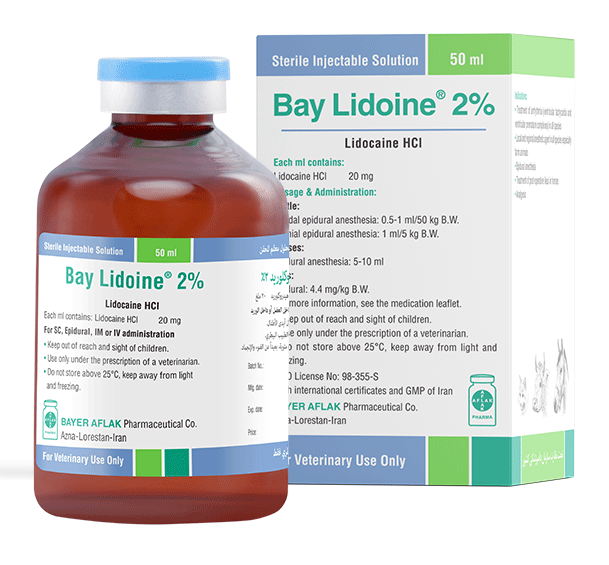
Sterile Injectable Solution
Therapeutically classification: Local anesthetic and antiarrhythmic
Composition: Each ml contains:
Lidocaine hydrochloride 20 mg
Target species: Horses, Cattle, Dogs and Cats
Indications:
Treatment of arrhythmia (ventricular tachycardia and ventricular premature complexes) in all species
Local and regional anesthetic agent in all species especially farm animals
Epidural anesthesia
Treatment of post-operative ileus in horses
Analgesic
Mechanism of action:
Lidocaine is considered to be a class IB (membrane-stabilizing) antidysrhythmic agent. Local anesthetics inhibit the production and conduction of nerve impulses. However, the drug interferes with the permeability of the cell membrane to sodium ions, thereby reducing membrane permeability and blocking the conduction of nerve waves. In other words, these drugs inhibit nerve cell membrane depolarization, thereby preventing the propagation of action potential and subsequent nerve impulse conduction and affecting the anesthetic effect of the drug. Lidocaine directly reduces spontaneous depolarization and ventricular excitability during diastolic stage 4 with direct effect on the muscle tissue of the heart and especially the Purkinje network.
Dosage & Administration:
Cattle:
Caudal epidural anesthesia: 0.5-1 ml/50 kg B.W.
Cranial epidural anesthesia: 1 ml/5 kg B.W.
Horses:
Maxillary nerve anesthesia: 10-20 ml
Epidural anesthesia: 5-10 ml
Treatment of arrhythmia: 0.25-0.5 mg/kg each 5-15 min by IV administration, for a total of 1.5 mg/kg, then as a CRI of 0.05 mg/kg/min
Treatment of Postoperative ileus: 1.3 mg/kg by IV administration over 15 min, followed as a CRI of 0.05 mg/kg/min
Dogs:
Antiarrhythmic: 1-2 mg/kg by IV administration during 30 s and increase to 4 mg/kg B.W. if there has been no response.
Epidural: 4.4 mg/ kg B.W. to anesthetize up to the first lumbar vertebra (L1).
Cats
Antiarrhythmic: Loading dose of 0.5-1 mg/kg IV, followed by 10-20 µg/kg/min (0.6-1.2 mg/kg/hr.) IV CRI.
Withdrawal time:
Meat: 3 days after the last treatment
Milk: 2 days after the last treatment
Contra-indications:
Do not use in hypersensitivity to lidocaine.
Do not use in infectious tissues and foci.
In the presence of septicemia, severe bleeding, hypotension, shock, complete cardiac block, should not be injected into the subarachnoid space.
High doses cause drowsiness, vomiting, seizure, nystagmus, sudden brain-heart attack, Excitement, hypotension, increase conduction of waves and atrioventricular contractions.
Caution:
Cats are reportedly very sensitive to the CNS effects of lidocaine, monitor carefully and treat seizures with diazepam.
Keep out of reach and sight of children.
Use only under the prescription of a veterinarian.
In use stability:
28 days after first needle insertion.
Storage:
Do not store above 25°C, keep away from light and freezing.
Packing:
50 ml vial in a box
For veterinary use only